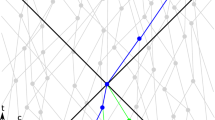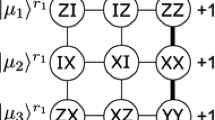Abstract
Parallel lives is a model which provides an interpretation of quantum theory that is both local and realistic. This model assumes that all quantum fields are composed of point beings called “lives”. Lives interact locally and have a memory of their previous interactions. The reduction of the state vector is not included in this model: lives can be divided into different worlds. This feature resembles many worlds interpretation. However in the parallel lives model, the division of lives into different worlds takes place locally. The parallel lives model is expected to be compatible with special relativity, as the lives propagate at a speed that does not exceed the speed of light and interact locally. On the other hand, it is open to paradoxes based on counterfactual propositions, as it provides a realistic interpretation of quantum theory. In this paper, we confront the parallel lives model with the paradox proposed by Hardy (Phys Rev Lett 68:2981–2984, 1992). We show that the parallel lives model cannot overcome the dilemma in Hardy’s paradox. We discuss implications of this confrontation on special theory of relativity, and speculate a solution that we believe, fits the spirit of the parallel lives model.






Similar content being viewed by others
Notes
Here we should note that not all lives in a macroscopic system need to interact with each other, but they must be part of the same network of interactions. The interaction waves propagating through the macroscopic system form a network of interactions and the memory of a distant live is shared in this way.
Otherwise, we cannot eliminate the superdeterminism option.
According to weak anthropic principle, the observer is in one of the relative worlds just because she observes the measurement result in that relative world.
Unless otherwise stated, reality will be used in the sense of ontological reality.
Here we should note that the inferences of observers in LAB, \(S^+\) and \(S^-\) frames about particle trajectories (\(u^+\) and \(u^-\)) are counterfactual. They don’t make measurements to determine real paths, but they infer these results from \(D^+\) and \(D^-\) detections via counterfactual reasoning.
This is evident from Eq. (2), but it is also conceivable from pair annihilation process at point P. If the particles take paths \(u^+\) and \(u^-\), then pair annihilation occur. In this case, the positron and electron turn into two photon and do not leave any signal in the detectors \(D^+,D^-,C^+,C^-\). If we have additional photon detectors, we can capture photon signals from pair annihilation. However, since we restrict ourselves to the situation where both \(D^+\) and \(D^-\) detectors detect signals, there should be no pair annihilation in the world of the LAB frame.
we omit the subscript “1.” for abbreviation.
Conventional Lorentz transformations in the symmetrical form.
Even the speeds of light pulses from K to \(D^-\) and K to \(D^+\) may not be equal.
Of course, there is no state vector collapse in the PL model. But since we think many physicists are more familiar with this terminology, we use the term “collapse” for clarity.
References
Hardy, L.: Quantum mechanics, local realistic theories, and Lorentz-invariant realistic theories. Phys. Rev. Lett. 68, 2981–2984 (1992)
Brassard, G., Raymond-Robichaud, P.: Can free will emerge from determinism in quantum theory? In: Suarez, A., Adams, P. (eds.) Is Science Compatible with Free Will? Exploring Free Will and Consciousness in Light of Quantum Physics and Neuroscience, Chapter 4, pp. 41–61. Springer, Berlin (2013). arXiv:1204.2128 [quant-ph]
Brassard, G., Raymond-Robichaud, P.: Parallel lives: a local-realistic interpretation of nonlocal boxes. Entropy 21(1), 87 (2019). arXiv:1709.10016 [quant-ph]
Waegell, M.: An ontology of nature with local causality, parallel lives, and many relative worlds, Found. Phys. 48(12), 1698–1730 (2018). arXiv:1707.06324 [quant-ph]
III Everett, H.: Relative state formulation of quantum mechanics. Rev. Mod. Phys. 29(3), 454 (1957)
DeWitt, B.S.: Phys. Today 23(9), 30 (1970)
Bell, J.S.: On the Einstein–Podolsky–Rosen paradox. Physics 1, 195–200 (1964)
Clauser, J.F., Horne, M.A., Shimony, A., Holt, R.A.: Proposed experiment to test local hidden-variable theories. Phys. Rev. Lett. 23, 880 (1969)
Conway, J., Kochen, S.: The free will theorem, Found. Phys. 36(10), 1441–1473 (2006). arXiv:0604079 [quant-ph]
Waegell, M.: Locally causal and deterministic interpretations of quantum mechanics: parallel lives and cosmic inflation, Quantum Stud. Math. Found. 4, 323–337 (2017). arXiv:1604.07874 [quant-ph]
Clifton, R., Pagonis, C., Pitowsky, I.: Relativity, quantum mechanics and EPR. In: Proceedings of the Biennial Meeting of the Philosophy of Science Association, Vol. 1, pp. 114–128 (1992)
Pitowsky, I.: The relativity of quantum predictions. Phys. Lett. A 156, 137–139 (1991)
Aharonov, Y., et al.: Revisiting Hardys paradox: counterfactual statements, real measurements, entanglement and weak values. Phys. Lett. A 301, 130–138 (2002)
Vaidman, L.: Counterfactuals in quantum mechanics. In: Greenberger, D., Hentschel, K., Weinert, F. (eds.) Compendium of Quantum Physics. Springer, Berlin (2009)
Einstein, A., Podolsky, B., Rosen, N.: Can quantum-mechanical description of physical reality be considered complete? Phys. Rev. 47, 777 (1935)
Müller, M.P.: Law without law: from observer states to physics via algorithmic information theory. arXiv:1712.01826 [quant-ph]
Will, C.M.: Theory and Experiment in Gravitational Physics. Cambridge University Press, Cambridge (1993)
Coleman, S.R., Glashow, S.L.: Cosmic ray and neutrino tests of special relativity, Phys. Lett. B 405, 249–252 (1997). arXiv:hep-ph/9703240 [hep-ph]
Barbour, J.: The End of Time. Oxford University Press, Oxford (1999)
Author information
Authors and Affiliations
Corresponding author
Additional information
Publisher's Note
Springer Nature remains neutral with regard to jurisdictional claims in published maps and institutional affiliations.
Rights and permissions
About this article
Cite this article
Şahin, İ. Can Parallel Lives Provide a Solution to Hardy’s Paradox?. Found Phys 51, 9 (2021). https://doi.org/10.1007/s10701-021-00418-z
Received:
Accepted:
Published:
DOI: https://doi.org/10.1007/s10701-021-00418-z




